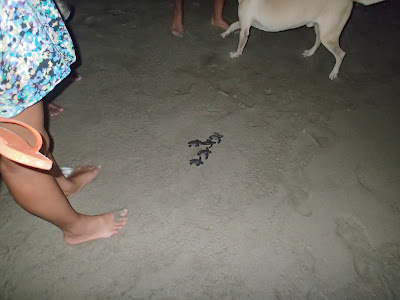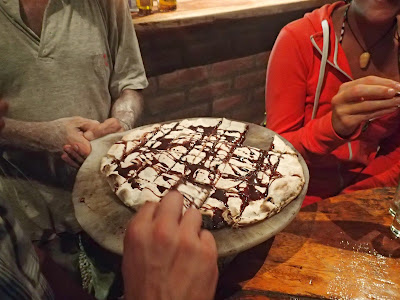On Friday November 22, 2013 I left the Pacific coast and ventured inland for the first time since the start of my journey. I needed a change of scenery and Lago de Nicaragua was the solution. Lago de Nicaragua is the largest lake in Central America and, interestingly, is home to freshwater bull sharks and sawfish. It also contributes to the atmospheric conditions that create the infamous winds that blow out toward the Pacific Ocean 300 days of the year. This phenomenon helped make Nicaragua the surf destination that it is; the consistent offshore winds hold-up the faces of waves until their highest peak, promoting a good shape and a better ride. Four friends from Castaway and I decided to explore two areas on the lake, Ometepe and Granada.
 |
| Isla de Ometepe (A) & Granada (B) on Lago de Nicaragua |
The five of us boarded a ferry at San Jorge for Isla de Ometepe. Ometepe is an island within Lago de Nicaragua formed by the volcanoes Concepción and Maderas. We stayed at
Santa Cruz Hostel & Restaurant, which had a great view of Volcán Concepción - an active, textbook cone-shaped volcano.
 |
| Isla de Ometepe with Volcán Concepción on the left and Volcán Maderas on the right |
 |
| Our view of Volcán Concepción from Hospedaje de Santa Cruz |
The first trip we did on the island was to the spring, Ojo de Agua. We borrowed some bikes and set off down the cobblestone streets, past signs outlining the evacuation route in the event of a volcanic eruption and numerous comedors, which are locals' homes that double as restaurants. From what I gathered from the Spanish presentation upon arrival to the spring, the Ojo de Agua is a mineral spring with healing properties. I was told that a 100 year-old local man swam in the spring and claimed that he felt as if he were 40 again. I reckon that the spring does not have magical healing properties and that he was just pulling my leg, for my cold that I had been fighting for several days prior got much worse after spending the day in the water. Nevertheless, it was a blast horsing around in the crystal-clear waters.
 |
| Biking around Ometepe |
 |
| Ojo de Agua |
 |
| The gang |
The next day we hired a guide and climbed Volcán Maderas. Maderas is an inactive volcano with an elevation of 1394 metres above sea level. The top of the volcano is covered in a cloud forest, which has a very eerie feel. Through the mist it is incredibly green with moss and peculiar vegetation, such as a fern shaped like a monkey's tail. It was also much cooler in the cloud forest, like natural air-conditioning. As we hiked we were constantly watched by, and heard the yells of, Capuchin and Howler monkeys high in the canopy. Descending 200 metres into the crater of the volcano we were rewarded with a lake. Despite only being about a 12 kilometre hike, the perpetual mist and rains of the cloud forest made for a muddy and slick trail that took us nearly 10 hours to cover.
 |
| Hike through the cloud forest |
 |
| Guardian of the cloud forest? |
 |
| Breakfast |
 |
| Monkey tail -shaped fern |
 |
| Lake within the crater of Volcán Maderas |
On Monday November 25th we got back on the ferry and met Marcos, a local from Ometepe with a van, who offered to drive us right to Granada for 100 córdobas ($4 US) a person. Granada is an old colonial town with beautiful architecture and buildings of various colours. The town was decorated with fake trees, bows and lights in preparation for the Christmas holidays. Numerous cafés, bookstores and the market kept me busy during the day. In the evenings, both tourists and locals would flood one street that was lined with restaurants on both sides with tables spilling onto the street. While we ate, artisans, break-dancers and musicians would wander the street to try and make a buck.
 |
| The Christmas tree in Granada's central park |
 |
| Cathedral in the heart of Granada, right in the central park |
 |
| Another cathedral |
 |
| Bustling market in Granada |
 |
| Break-dancers performing in the main strip |
Granada is also a great hub for various day trips, including a tour of the isletas de Granada. We took a boat tour of the various islands on Lago de Nicaragua near Granada, some of which are inhabited. The highlight was definitely seeing the Spider monkeys, one of which was even brave enough to join us on the boat.
 |
| Isletas de Granada |
 |
| Just monkeying around |
 |
| Spider Monkey |
 |
| Friendly little dude |
The vibe of the old colonial town provoked me to splurge a little more than I was used to at the beach. In addition to all the cafés, restaurants and pubs, I decided to get a hot shave. The barberia was equipped with old-school metal chairs with red leather upholstery, right in the centre of the colonial town. Other than the fact that Nicaragua doesn't have hot water and the damp towel was cold, the straight razor shave was exactly how I imagined it - bad-ass.
 |
| My first straight razor shave |
To prolong the feeling of being wealthy, traveling businessmen rather than poor, stingy backpackers, we went to
Mombacho Cigar Lounge. Here we got a tour of the lounge in which the entire cigar-making process was explained, from tobacco seed to quality, aged cigars. Afterward, we bought a couple of stogies and Toña cervezas and lounged by the complimentary pool reading their expensive magazines full of cars and watches that we'll probably never be able to afford. Nevertheless, we still felt as if we were worth a million bucks...
 |
| Cigar-rolling workstations |
 |
| Hard-at-work |
 |
| Drying tobacco leaves |
 |
| The lounge |
 |
| Ready to relax |
 |
| Tom and I enjoying a Mombachito |
 |
| Just another day |
I've had a blast in Ometepe and Granada the past week, but it's time to get back to the beach life. Tomorrow I'll be on my way to one of Nicaragua's most famous breaks, 'The Boom'.




























































